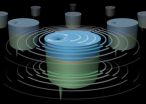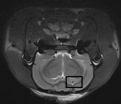(Press-News.org) UPTON, NY—Scientists at the U.S. Department of Energy's Brookhaven National Laboratory are seeking ways to synchronize the magnetic spins in nanoscale devices to build tiny yet more powerful signal-generating or receiving antennas and other electronics. Their latest work, published in Nature Communications, shows that stacked nanoscale magnetic vortices separated by an extremely thin layer of copper can be driven to operate in unison, potentially producing a powerful signal that could be put to work in a new generation of cell phones, computers, and other applications.
The aim of this "spintronic" technology revolution is to harness the power of an electron's "spin," the property responsible for magnetism, rather than its negative charge.
"Almost all of today's electronic technology, from the light bulb to the smartphone, involves the movement of charge," said Brookhaven physicist Javier Pulecio, lead author on the new study. "But harnessing spin could open the door for much more compact and novel types of antennas that act as spin wave emitters, signal generators—such as the clocks that synchronize everything that goes on inside a computer—as well as memory and logic devices."
The secret to harnessing spin is to control its evolution and spin configuration.
"If you grab a circular refrigerator magnet and place it under a microscope that could image electron spins, you would see the magnet has several regions called domains, where within each domain all the spins point in the same direction," explained group leader Yimei Zhu. "If you were to shrink that magnet down to a size smaller than a red blood cell, the spins inside the magnet will begin to align themselves into unique spin textures."
For example, in a magnetic disc with a radius of just 500 nanometers (billionths of a meter) and a thickness of just 25 nanometers, the disc can no longer support multiple domains and the spins align in a hurricane-like rotational pattern to reduce the overall magnetic energy. The spins parallel to the disc's surface rotate around a core, much like the eye of the hurricane, either clockwise or anticlockwise. And at the core, the magnetic spins point out of the disc's surface, either up or down. So this structure, a magnetic vortex, has four possible states—up or down paired with clockwise or anticlockwise.
What's more, the core of the magnetic vortex can be moved around within a nanodisc by applying either an electric current or an external magnetic field, "so it behaves much like a particle—a quasi-particle," Pulecio said. Applying certain high-frequency electromagnetic excitations can set the vortex core moving in a circular motion about the center of the disc. These circular motions, or oscillations, are what scientists hope to put to use.
"Magnetic vortex-based oscillators can be tuned to operate at different narrowly defined frequencies, making them extremely flexible for telecommunications applications," Pulecio said. "They are also self-contained elements, about 100,000 times smaller than oscillators based on voltage instead of spin, so they could prove to be less expensive, consuming less electricity, and won't take up as much room on the device. That's especially important if you are talking about miniaturization for cell phones, wearable electronics, tablets, and so on."
For now, however, the power output of these spintronic devices is relatively small compared with oscillator technologies currently in use. So scientists are exploring ways to synchronize the oscillations of multiple magnetic vortices.
In the Nature Communications paper, Pulecio, Zhu, and their collaborators at the Swiss Light Source, Brookhaven's National Synchrotron Light Source, and Stony Brook University explored expanding the device in three dimensions by stacking one vortex on top of another, with the individual discs separated by a thin non-magnetic layer. They investigated how changing the thickness of the non-magnetic layer affected the fundamental interactions at the nanoscale, and how those, in turn, affected the coupled dynamics of the vortices. They directly imaged how the vortices responded to high-frequency stimulation using high-resolution Lorentz transmission electron microscopy imaging.
The results: A thicker separating layer resulted in somewhat unordered motion of the coupled vortices in the two discs. The thinner the separating layer, the stronger the vortices were linked, synching up in space into coherent circular motion. This could help to overcome the power limitations of current vortex-based spintronic antennas by creating arrays of synchronized tiny oscillators through coupled 3D stacks.
The scientists are currently working with other more exotic systems to understand the dynamics in both time and space that could make spintronic technologies a reality.
"Magnetic vortices were one of the first observed magnetic quasi-particles and we are currently looking to expand our investigations to observe other newly discovered spin textures and how we might harness those," Pulecio said.
INFORMATION:
This research was supported by the Core-Research Programs within Basic Energy Science, DOE Office of Science. Fabrication of the devices was supported in part by the Center for Functional Nanomaterials at Brookhaven National Laboratory.
DOE's Office of Science is the single largest supporter of basic research in the physical sciences in the United States, and is working to address some of the most pressing challenges of our time. For more information, please visit science.energy.gov.
Related Links
Scientific paper: "Coherence and modality of driven interlayer coupled magnetic vortices" DOI: 10.1038/ncomms4760
Harnessing magnetic vortices for making nanoscale antennas
Scientists explore ways to synchronize spins for more powerful nanoscale electronic devices
2014-04-30
ELSE PRESS RELEASES FROM THIS DATE:
NOAA-led researchers discover ocean acidity is dissolving shells of tiny snails off West Coast
2014-04-30
A NOAA-led research team has found the first evidence that acidity of continental shelf waters off the West Coast is dissolving the shells of tiny free-swimming marine snails, called pteropods, which provide food for pink salmon, mackerel and herring, according to a new paper published in Proceedings of the Royal Society B.
Researchers estimate that the percentage of pteropods in this region with dissolving shells due to ocean acidification has doubled in the nearshore habitat since the pre-industrial era and is on track to triple by 2050 when coastal waters become 70 ...
Neiker-Tecnalia studies the effects of climate change on Tempranillo grape wines
2014-04-30
Climate change is set to affect the quality of the wines of the Tempranillo grape variety, according to the conclusions of a piece of research conducted by the Basque Institute for Agricultural Research and Development Neiker-Tecnalia, in collaboration with the University of Navarre and the Aula Dei (EEAD) Experimental Station of the National Council for Scientific Research (CSIC). Scientists from these bodies have studied the behaviour of the vines in conditions of climate change; in other words, higher temperature, increased presence of CO2 and greater environmental aridity. ...
7.0T NMR assesses changes in hippocampal neurons in animal models of Alzheimer's disease
2014-04-30
Magnetic resonance spectroscopy can quantitatively analyze in vivo abnormalities of biochemical metabolism within brain tissue in a noninvasive and non-radioactive manner. Compared with 3.0T magnetic resonance spectroscopy, high-field magnetic resonance spectroscopy (≥ 7.0T) exhibits high spatial resolution and density resolution, microscopic imaging of the living body, and obtains both high scanning resolution and result precision within a shorter scan time, thus providing a higher value in clinical diagnosis. In a recent study reported in the Neural Regeneration ...
A researcher from the University of Cádiz discovers 18 new species of molluscs
2014-04-30
Molluscs are invertebrates that make up one of the most numerous groups in the animal kingdom. They are everywhere, from great heights of over 3,000m above sea level to ocean profundities of over 5,000m deep, in polar and tropical waters and they tend to be common elements on coastlines around the world. Within this animal group are found the nudibranchs, characterized among other things, for not having shells and being brightly coloured. This colouring alerts their predators to their toxicity. Within this group, in turn, we can find the Aeolidiidae family.
This family ...
Deep brain stimulation for obsessive-compulsive disorder releases dopamine in the brain
2014-04-30
Philadelphia, PA, April 30, 2014 – Some have characterized dopamine as the elixir of pleasure because so many rewarding stimuli – food, drugs, sex, exercise – trigger its release in the brain. However, more than a decade of research indicates that when drug use becomes compulsive, the related dopamine release becomes deficient in the striatum, a brain region that is involved in reward and behavioral control.
New research now published in Biological Psychiatry from the Academic Medical Center in Amsterdam suggests that dopamine release is increased in obsessive-compulsive ...
Candid 'insider' views in the NHS could help detect reasons for poor care
2014-04-30
Asking NHS staff about what affects whether they would recommend their organisation for family and friends is an important source of intelligence for improving quality and safety of care, says a new study.
This finding by researchers in the Universities of Leicester, Aberdeen, and Bristol has been published in a paper, 'The friends and family test: a qualitative study of concerns that influence the willingness of English National Health Service staff to recommend their organisation', in the Journal of the Royal Society of Medicine.
Since 2009, the annual Staff Survey ...
Greater surgeon experience increases likelihood of mitral valve repair vs. replacement
2014-04-30
Toronto, ON, Canada, April 30, 2014 – A new study presenting data from 17 cardiac surgical centers in Virginia, representing 100 surgeons and 99% of cardiac operations performed in the state, demonstrates that, even today, significant variations – among surgeons and hospitals - still exist in the performance of mitral valve repair vs replacement for moderate to severe mitral regurgitation. Significant associations were observed between the propensity for MV repair and both institutional and surgeon annual volume, although increasing surgeon volume appears to be the much ...
CT in the operating room allows more precise removal of small lung cancers
2014-04-30
Toronto, ON, Canada, April 30, 2014 – A new technique that brings CT imaging into the operating room will allow surgeons to precisely demarcate and remove small sub-centimeter lung nodules, leaving as much healthy tissue as possible, according to Raphael Bueno, MD, of Brigham and Women's Hospital in Boston. His team is presenting the results of this late-breaking research at the 94th AATS Annual Meeting in Toronto, ON, Canada on April 30, 2014.
Lung cancer remains the deadliest cancer and a recent study, the National Lung Cancer Screening Trial, indicated that screening ...
New lab-on-a-chip device overcomes miniaturization problems
2014-04-30
UNSW Australia chemists have invented a new type of tiny lab-on-a-chip device that could have a diverse range of applications, including to detect toxic gases, fabricate integrated circuits and screen biological molecules.
The novel technique developed by the UNSW team involves printing a pattern of miniscule droplets of a special solvent onto a gold-coated or glass surface.
"We use a class of 'green' solvents called ionic liquids, which are salts that are liquid at room temperature. They are non-volatile, so this overcomes one of the main problems in making useful miniaturised ...
MRI shows disrupted connections in the brains of young people with ADHD
2014-04-30
OAK BROOK, Ill. – A new study has found that children and adolescents with attention deficit hyperactivity disorder (ADHD) have disrupted connections between different areas of the brain that are evident on resting-state functional magnetic resonance imaging (rfMRI). The results of this research are published online in the journal Radiology.
The findings point to the potential of rfMRI to help provide objectively accurate, early diagnosis of a disorder that affects approximately 5 percent of children and adolescents worldwide.
ADHD is a disorder characterized by age-inappropriate ...
LAST 30 PRESS RELEASES:
How cells balance their protein levels
Nirsevimab vs RSVpreF vaccine for RSV–related hospitalization in newborns
Effectiveness and impact of maternal RSV immunization and nirsevimab on medically attended RSV in US children
AI gives scientists a boost, but at the cost of too many mediocre papers
Next-generation vision model maps tree growth at sub-meter precision
Genes aren’t destiny for inherited blindness, study shows
MIT study: High-fat diets make liver cells more likely to become cancerous
Exposure to multiple fine particulate matter components and incident depression in the US Medicare population
Risk of burdensome health care spending over time in the US
Nirsevimab against hospitalizations and emergency department visits for lower respiratory tract infection in infants
New microfluidics technology enables highly uniform DNA condensate formation
A new strategy for immune tolerance
Super Mario Bros. help fight burnout: New study links classic games to boosted happiness
Deepest gas hydrate cold seep ever discovered in the arctic: International research team unveils Freya Hydrate Mounds at 3,640 m depth.
Integrating light and structure: Smarter mapping for fragile wetland ecosystems
ACA-SIM: A robust way to decode satellite signals over complex waters
Probiotics can restore gut microbiome in breastfed infants
AI could help predict nutrition risks in ICU patients, study finds
Federal EITC has unexpected result, researchers say – it decreases domestic violence
Researchers identify gene that calms the mind and improves attention in mice
Artificial metabolism turns waste CO2 into useful chemicals
Ancient sea anemone sheds light on animal cell type evolution
Begging gene leads to drone food
How climate policies that incentivize and penalize can drive the clean energy transition
Can community awareness campaigns in low-resource areas improve early diagnosis of colorectal cancer?
Stardust study resets how life’s atoms spread through space
Practical education: Clinical scenario-based program development
The impact of family dynamics on eating behaviour – how going home for Christmas can change how you eat
Tracing the quick synthesis of an industrially important catalyst
New software sheds light on cancer’s hidden genetic networks
[Press-News.org] Harnessing magnetic vortices for making nanoscale antennasScientists explore ways to synchronize spins for more powerful nanoscale electronic devices


